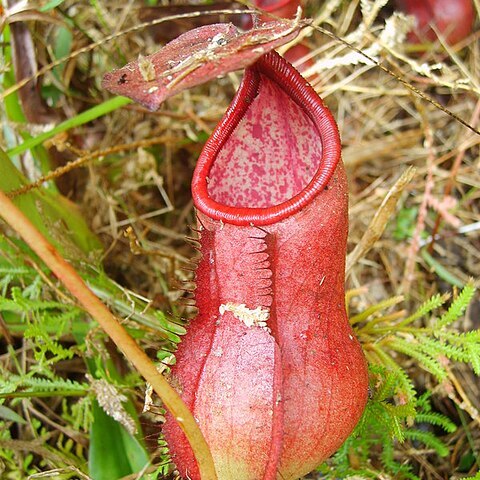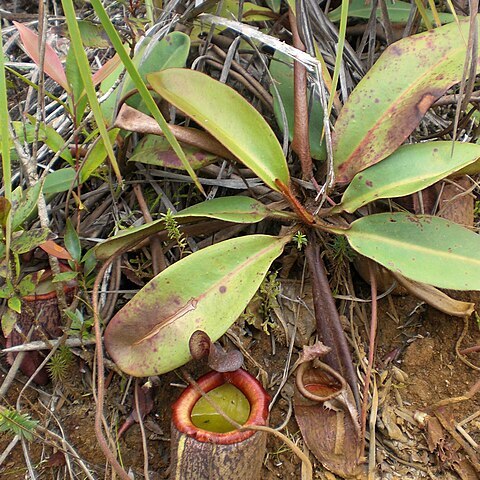Carnivorous, dioecious, woody or subwoody climbers or subshrubs, terrestrial or epiphytic. Stems terete or 2-4-angled, or winged. Buds naked, lacking scales. Phyllotaxy spiral, 2/5 or 1/2. Leaves exstipulate; involute or convolute, marcescent, simple, chartaceous or coriaceous, petiolate or sessile; midrib extended into an unbranched tendril, the distal part of which expands into an elaborate, animal trapping receptacle (pitcher) containing digestive fluid. Pitchers dimorphic. Lower pitchers produced from rosettes or short stems, often resting on the ground, usually ovoid or globular, the mouth facing towards the stem, with two ventral fringed wings running from the base to the pitcher rim and with the tendril straight, not coiled. Upper pitchers (usually absent in N. argentii, N. ampullaria, and N. pectinata) usually more elongated and infundibuliform (funnel-shaped) than the lower pitchers, the mouth facing away from the stem, the wings reduced to ridges and not fimbriate, or absent, and the tendril coiled. Pitcher mouth apical or subapical, rimmed with a ribbed peristome (except N. inermis), the inner edge often toothed and bearing nectar glands, at the rear sometimes raised to form a column, supporting the lid; lid usually held over the mouth (reflexed e.g. in N. dubia), lower surface with a laterally flattened basal appendage, rarely an apical filiform appendage, or appendages absent; nectar glands usually abundant; spur inserted on dorsal surface at junction with lid, entire or variously divided, flattened or terete. Inflorescence terminal, appearing lateral by subsequent growth, a paniculoid thyrse or raceme, of 6-300 flowers, the main axis with indeterminate growth, the partial inflorescences 1-flowered (racemose) or 2-flowered, less usually 3-40-flowered, bracteate or ebracteate. Perianth imbricate, a single whorl of 4 (also interpreted as two whorls of 2) free or basally united, patent, nectariferous tepals. Female flowers with androecium lacking, ovary superior, 4-carpellate, incompletely 4-locular locules antitepalous, placentation lamellar, ovules erect, anatropous, bitegmic, crassinucellate, 200-500, stigmas sessile, as many as locules. Male inflorescence usually larger and more floriferous, perianth as in female; stamens 4-?12, filaments united into an androphore, anthers tetrasporangiate, in 1-3 dense whorls, united into a subspherical anther head, locules opening by longitudinal slits, extrorse; gynoecium lacking. Fruit sometimes stipitate, a loculicidally dehiscent capsule with 4 valves containing 50-500 seeds. Seeds filiform, 3-25 mm long, slender due to long basal and apical appendages. Testa reduced to an outer epidermis with thick outer walls to the cells and irregular thickenings on the radial and inner walls. Tegmen produced only around the embryonic cavity, crushed. Endosperm starchy or absent. Embryo minute, central, straight or U-shaped in a subellipsoid cavity, cotyledons and hypocotyl well-developed, though minute. Indumentum of simple, bifid, fasciculate, stellate, dendritic non-glandular and sunken, sessile or shortly stipitate glandular hairs. Colour of pitchers entirely green, or yellow or orange or white or purple or red, often marked with red streaks or blotches; peristome often glossy red; inflorescence with green, brown or red tepals. 2n = 80.
More
Dioecious, mainly insectivorous pitcher-bearing vines, typically climbing by means of tendrils, or subscandent, prostrate or occasionally erect or shrubby, young plants rosetted, leaves congested along main axis, internodes lengthening as plants mature. Leaves alternate, spiral or rarely distichous, petiolate, sessile or amplexicaul, in outline generally elliptic, oblong or linear, rarely orbiculate, apices acuminate, acute or obtuse; the leaf unit comprises a lamina, emergent tendril and pitcher, the latter developing from the distal portion of the tendril and comprising an ascidium (pitcher) with a variably glandular inner wall that facilitates the digestion and assimilation of trapped organic material, surmounted by an overarching to reflexed operculum (lid) with a spur at its base on the outside of the pitcher and, usually, a conspicuous peristome (recurved rim) bearing a characteristic regular pattern of radial ridges which, on the inner edge, form fine terminal processes (teeth); pitchers of rosette leaves generally robust, facing tendril and resting on the ground, those of vining stems more gracile, facing away from tendril, the tendril itself often coiled, wrapping around supports to aid climbing. Inflorescence a panicle, in most species reduced to racemose botryoid form, bracteate or not, terminal, appearing lateral owing to continued growth of main axis from development of the subtending axillary bud, flowers borne from partial peduncles arising from rachis, opening acropetally. Flowers unisexual, actinomophic, apetalous, perianth consisting of four free, decussate tepals in two whorls, adaxial surfaces bearing usually large multiseriate nectar glands. Male flowers bearing (4–) 8–24 stamens connate in a central column, anthers 2-locular, longitudinally extrorse, pollen united in tetrads, inaperturate, spinulose–psilate. Female flowers bearing a superior compound ovary, usually comprising 4 fused carpels with as many locules; ovules numerous, axile or laminar, anatropous; stigma apical, discoid, lobate, sessile or on very short, stout style. Capsule dehisces longitudinally and loculicidally into 4 valves, seeds fusiform to filiform, 5–25 mm long.
Morphological characters and geographical distribution are the same as those for the family.
USES The main value of Nepenthes in international commerce is in the horticultural trade, where it probably far exceeds 15 million dollars per annum in our estimation (see ‘Conservation’, p. 13). In SE Asia, the use of N. mirabilis as toy phallocrypts in New Guinea is probably the most obscure. Stems of several species are used for making rope, that of N. ampullaria being considered of particularly good quality, being very durable when used in, for ex-ample, tying fences. Fluid from unopened pitchers is potable (pers. obs.) and used to treat inflammation of the eyes and both indigestion and other stomach problems. Boiled roots of N. ampullaria and N. gracilis have both been used to treat stomachache. Nepenthes reinwardtiana has been used to facilitate healing of skin and as an astringent. Opened pitchers of the larger pitchers are used to cook rice in, imparting an interesting flavour. The last use is reflected in one of the common names of many species in various languages, which translates as ‘monkeys’ rice pots’. Other common names which may reflect uses translate as ‘monkeys’ goblet’ and ‘monkeys’ water-scooper’. A detailed compilation of common names based on those recorded on herbarium specimens is given by Danser (1928) from which most of the above uses have been obtained. Reference: Danser, B.H. The Nepenthaceae of the Netherlands Indies Bull. Jard. Bot. Buitenzorg III 9 1928 249-438
More
Increasingly popular in horticulture as display plants for their unusual and often striking pitchers. This is partly due to the creation of easy to grow hybrids that are resilient enough to pitcher in relatively low household humidity, as well as winter tolerances that allow certain examples to be cultivated out of doors year round as far south as metropolitan Melbourne, with its relatively warm, maritime winter climate.


